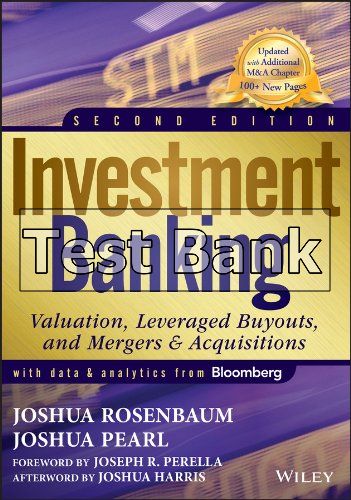Investment Banking Valuation Leveraged Buyouts and Mergers and Acquisitions 2nd Edition Rosenbaum Test Bank

Product details:
- ISBN-10 : 1118656210
- ISBN-13 : 978-1118656211
- Author: Joshua Rosenbaum, Joshua Pearl
Investment Banking: Valuation, Leveraged Buyouts, and Mergers & Acquisitions, Second Edition is a highly accessible and authoritative book that focuses on the primary valuation methodologies currently used on Wall Street–comparable companies, precedent transactions, DCF, and LBO analysis–as well as M&A analysis. These methodologies are used to determine valuation for public and private companies within the context of M&A transactions, LBOs, IPOs, restructurings, and investment decisions. Using a step-by-step how-to approach for each methodology, the authors build a chronological knowledge base and define key terms, financial concepts, and processes throughout the book. They also provide a comprehensive overview of the fundamentals of LBOs and an organized M&A sale process, as well as merger consequences analysis.
Table contents:
Introduction 1
Structure of the Book 3
Part One: Valuation (Chapters 1–3) 3
Part Two: Leveraged Buyouts (Chapters 4 & 5) 5
Part Three: Mergers & Acquisitions (Chapters 6 & 7) 6
Part Four: Initial Public Offerings (Chapters 8 & 9) 8
ValueCo Summary Financial Information 9
Part One Valuation 11
Chapter 1 Comparable Companies Analysis 13
Summary of Comparable Companies Analysis Steps 14
Step I. Select the Universe of Comparable Companies 17
Study the Target 17
Identify Key Characteristics of the Target for Comparison Purposes 18
Screen for Comparable Companies 22
Step II. Locate The Necessary Financial Information 23
SEC Filings: 10-K, 10-Q, 8-K, and Proxy Statement 24
Equity Research 25
Press Releases and News Runs 26
Financial Information Services 26
Summary of Financial Data Primary Sources 27
Step III. Spread Key Statistics, Ratios, and Trading Multiples 28
Calculation of Key Financial Statistics and Ratios 28
Supplemental Financial Concepts and Calculations 42
Calculation of Key Trading Multiples 47
Step IV. Benchmark the Comparable Companies 50
Benchmark the Financial Statistics and Ratios 50
Benchmark the Trading Multiples 50
Step V. Determine Valuation 51
Valuation Implied by EV/EBITDA 52
Valuation Implied by P/E 52
Key Pros and Cons 54
Illustrative Comparable Companies Analysis for ValueCo 55
Step I. Select the Universe of Comparable Companies 55
Step II. Locate the Necessary Financial Information 57
Step III. Spread Key Statistics, Ratios, and Trading Multiples 57
Step IV. Benchmark the Comparable Companies 69
Step V. Determine Valuation 74
Chapter 2 Precedent Transactions Analysis 75
Summary of Precedent Transactions Analysis Steps 76
Step I. Select the Universe of Comparable Acquisitions 79
Screen for Comparable Acquisitions 79
Examine Other Considerations 80
Step II. Locate the Necessary Deal-Related and Financial Information 82
Public Targets 82
Private Targets 85
Summary of Primary SEC Filings in M&A Transactions 86
Step III. Spread Key Statistics, Ratios, and Transaction Multiples 88
Calculation of Key Financial Statistics and Ratios 88
Calculation of Key Transaction Multiples 94
Step IV. Benchmark the Comparable Acquisitions 98
Step V. Determine Valuation 98
Key Pros and Cons 99
Illustrative Precedent Transaction Analysis for ValueCo 100
Step I. Select the Universe of Comparable Acquisitions 100
Step II. Locate the Necessary Deal-Related and Financial Information 101
Step III. Spread Key Statistics, Ratios, and Transaction Multiples 103
Step IV. Benchmark the Comparable Acquisitions 111
Step V. Determine Valuation 113
Chapter 3 Discounted Cash Flow Analysis 115
Summary of Discounted Cash Flow Analysis Steps 116
Step I. Study the Target and Determine Key Performance Drivers 120
Study the Target 120
Determine Key Performance Drivers 120
Step II. Project Free Cash Flow 121
Considerations for Projecting Free Cash Flow 121
Projection of Sales, EBITDA, and EBIT 123
Projection of Free Cash Flow 125
Step III. Calculate Weighted Average Cost of Capital 131
Step III(a): Determine Target Capital Structure 132
Step III(b): Estimate Cost of Debt (rd) 133
Step III(c): Estimate Cost of Equity (re) 134
Step III(d): Calculate WACC 138
Step IV. Determine Terminal Value 138
Exit Multiple Method 139
Perpetuity Growth Method 139
Step V. Calculate Present Value and Determine Valuation 141
Calculate Present Value 141
Determine Valuation 143
Perform Sensitivity Analysis 145
Key Pros and Cons 146
Illustrative Discounted Cash Flow Analysis for ValueCo 147
Step I. Study the Target and Determine Key Performance Drivers 147
Step II. Project Free Cash Flow 147
Projection of Sales, EBITDA, and EBIT 149
Step III. Calculate Weighted Average Cost of Capital 154
Step IV. Determine Terminal Value 159
Step V. Calculate Present Value and Determine Valuation 161
Part Two Leveraged Buyouts 167
Chapter 4 Leveraged Buyouts 169
Key Participants 171
Financial Sponsors 171
Investment Banks 172
Bank and Institutional Lenders 174
Bond Investors 175
Private Credit Funds 176
Target Management 176
Characteristics of a Strong LBO Candidate 177
Strong Cash Flow Generation 178
Leading and Defensible Market Positions 178
Growth Opportunities 178
Efficiency Enhancement Opportunities 179
Low Capex Requirements 179
Strong Asset Base 180
Proven Management Team 180
Economics of LBOs 181
Returns Analysis—Internal Rate of Return 181
Returns Analysis—Cash Return 182
How LBOs Generate Returns 182
How Leverage Is Used to Enhance Returns 184
Primary Exit/Monetization Strategies 187
Sale of Business 187
Initial Public Offering 188
Dividends / Dividend Recapitalization 188
Below Par Debt Repurchase 188
LBO Financing: Structure 189
LBO Financing: Primary Sources 192
Secured Debt 192
High Yield Bonds 196
Mezzanine Debt 198
Equity Contribution 199
LBO Financing: Selected Key Terms 202
Security 202
Seniority 202
Maturity 203
Coupon 204
Call Protection 205
Covenants 206
Term Sheets 209
LBO Financing: Determining Financing Structure 212
Chapter 5 LBO Analysis 217
Financing Structure 217
Valuation 218
Step I. Locate and Analyze the Necessary Information 220
Step II. Build the Pre-LBO Model 220
Step II(a): Build Historical and Projected Income Statement through EBIT 221
Step II(b): Input Opening Balance Sheet and Project Balance Sheet Items 224
Step II(c): Build Cash Flow Statement through Investing Activities 226
Operating Activities 226
Step III. Input Transaction Structure 229
Step III(a): Enter Purchase Price Assumptions 229
Step III(b): Enter Financing Structure into Sources and Uses 231
Step III(c): Link Sources and Uses to Balance Sheet Adjustments Columns 232
Uses of Funds Links 235
Step IV. Complete the Post-LBO Model 238
Step IV(a): Build Debt Schedule 238
Step IV(b): Complete Pro Forma Income Statement from EBIT to Net Income 247
Step IV(c): Complete Pro Forma Balance Sheet 250
Step IV(d): Complete Pro Forma Cash Flow Statement 252
Step V. Perform LBO Analysis 254
Step V(a): Analyze Financing Structure 254
Step V(b): Perform Returns Analysis 256
Step V(c): Determine Valuation 260
Step V(d): Create Transaction Summary Page 261
Illustrative LBO Analysis for ValueCo 262
Part Three Mergers & Acquisitions 273
Chapter 6 Sell-Side M&A 275
Auctions 276
Auction Structure 279
Organization and Preparation 279
Identify Seller Objectives and Determine Appropriate Sale Process 279
Perform Sell-Side Advisor Due Diligence and Preliminary Valuation Analysis 281
Select Buyer Universe 281
Prepare Marketing Materials 282
Prepare Confidentiality Agreement 285
First Round 286
Contact Prospective Buyers 286
Negotiate and Execute Confidentiality Agreement with Interested Parties 286
Distribute Confidential Information Memorandum and Initial Bid Procedures Letter 287
Prepare Management Presentation 288
Set Up Data Room 289
Prepare Stapled Financing Package (if applicable) 291
Receive Initial Bids and Select Buyers to Proceed to Second Round 291
Second Round 293
Conduct Management Presentations 293
Facilitate Site Visits 294
Provide Data Room Access and Respond to Diligence Requests 294
Distribute Final Bid Procedures Letter and Draft Definitive Agreement 295
Receive Final Bids 296
Negotiations 300
Evaluate Final Bids 300
Negotiate with Preferred Buyer(s) 300
Select Winning Bidder 300
Render Fairness Opinion (if required) 301
Receive Board/Owner Approval and Execute Definitive Agreement 301
Closing 302
Obtain Necessary Approvals 302
Shareholder Approval 303
Financing and Closing 305
Negotiated Sale 306
Chapter 7 Buy-Side M&A 309
Buyer Motivation 310
Synergies 311
Cost Synergies 312
Revenue Synergies 312
Acquisition Strategies 313
Horizontal Integration 313
Vertical Integration 313
Conglomeration 314
Form of Financing 315
Cash on Hand 316
Debt Financing 316
Equity Financing 317
Debt vs. Equity Financing Summary—Acquirer Perspective 318
Deal Structure 318
Stock Sale 318
Asset Sale 321
Stock Sales Treated as Asset Sales for Tax Purposes 324
Buy-Side Valuation 327
Football Field 327
Analysis at Various Prices 330
Contribution Analysis 331
Merger Consequences Analysis 333
Purchase Price Assumptions 333
Balance Sheet Effects 338
Accretion/(Dilution) Analysis 343
Acquisition Scenarios—I) 50% Stock/50% Cash; II) 100% Cash; and III) 100% Stock 346
Illustrative Merger Consequences Analysis for the BuyerCo/ValueCo Transaction 351
Part Four Initial Public Offerings 373
Chapter 8 Initial Public Offerings 375
Why Do Companies Go Public? 376
Characteristics of a Strong IPO Candidate 378
Attractive Industry 378
Strong Competitive Position 378
Growth Opportunities 379
Moat & Barriers to Entry 380
Healthy Financial Profile 380
Disruptive & Differentiated Solutions 381
Favorable Risk Profile 381
Proven Management Team 382
Key Participants 383
Investment Banks 383
Company Management 386
Current Owners/Investors 387
IPO Investors 387
Lawyers 388
Accountants 388
Exchange Partner 389
IPO Advisors 390
Vendors 390
Selected Key Terms 391
Offering Size 392
Primary/Secondary 393
Overallotment Option, a.k.a. “Greenshoe” 394
Syndicate Structure 395
Lock-up Provision 396
Listing Exchange 396
Gross Spread 397
Dual-Track Process 398
Special Purpose Acquisition Companies (Spac s) 401
Direct Listings 403
Post-IPO Equity Offerings 406
IPO Considerations 407
Nasdaq Appendix 409
Chapter 9 The IPO Process 413
Organization and Preparation 415
Select IPO Team, Exchange Partner and Assign Responsibilities 415
Manage Corporate Housekeeping 418
C Corp vs. Up-C Structure 423
Determine IPO Timing 425
Determine Offering Structure and Preliminary IPO Valuation 426
Host Organizational Meeting 429
Due Diligence, Drafting, and Filing 430
Perform Underwriter Due Diligence 430
Draft and File the Registration Statement 431
Prepare Other Key Transaction and Corporate Governance Documents 436
Coordinate with Equity Research 437
Respond to SEC Comments and File Amended Registration Statement 437
Marketing and Roadshow 438
Prepare Marketing Materials 438
Salesforce Teach-in 439
Conduct Roadshow 440
Build Order Book 443
Pricing and Allocation 445
Price the Offering 445
Allocate Shares to Investors 447
Closing 447
Afterword 449
Bibliography and Recommended Reading 451
Index 457
People also search:
investment banking valuation leveraged buyouts and mergers and acquisitions
investment banking leveraged finance
what is valuation in investment banking
what is leverage in investment banking
what is leveraged finance investment banking





